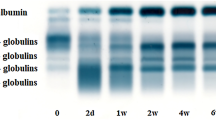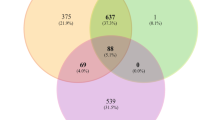Abstract
WHILE examining red-cell hæmolysates from baboons by starch-gel electrophoresis, using the discontinuous tris-borate system of Poulik1, individual variations were noticed in the main non-hæmoglobin protein (NHP) band after staining the starch gels with amidoschwarz. In most animals there was a single strong band in a position considerably behind the main NHP band of human hæmolysates run in parallel. In a few animals, however, only a faint band was seen in this position but there was a strong one at approximately the same level as the main band in man. In other animals both the slow (S) and fast (F) bands were present (Fig. 1). Fifty laboratory animals, originally caught in Kenya, yielded 4 examples of the Ftype and 11 of the F + Stype while the remaining 35 had only the slow main band. The proportions of the three types in the two sexes were closely similar in 17 animals the sex of which was recorded. Taxonomic identification was not easy because many of the animals were immature, but the majority was considered to be Papio cynocephalus and a few possibly P. anubis. In a further 126 hæmolysates from baboons from the South-west Foundation, San Antonio, Texas, there were only 4 SFtypes, the remainder having the Sband alone. Seventy-five animals were P. cynocephalus, 36 were from an inbred strain of uncertain origin and 15 were hybrids between these two stocks. Since the San Antonio P. cynocephaluswere known to have been imported from Kenya, the rarity of Fvariants in the sample suggests that its incidence may show wide local variations in wild baboon populations ; however, we have no details about the sampling involved in catching them. Only the Stype was found in 21 specimens of P. hamadryas.
This is a preview of subscription content, access via your institution
Access options
Subscribe to this journal
Receive 51 print issues and online access
$199.00 per year
only $3.90 per issue
Buy this article
- Purchase on Springer Link
- Instant access to full article PDF
Prices may be subject to local taxes which are calculated during checkout
Similar content being viewed by others
References
Poulik, M. D., Nature, 180, 1477 (1957).
Haut, A., Tudhope, C. R., Cartwright, G. E., and Wintrobe, M. M., J. Clin. Invest., 41, 579 (1962).
Shaw, Charles R., Syner, Frank N., and Tashian, Richard E., Science, 138, 31 (1962).
Waygood, E. Roy, Methods in Enzymology, edit. by Colowick and Kaplan, p. 837 (Academic Press, New York, 1955).
Author information
Authors and Affiliations
Rights and permissions
About this article
Cite this article
BARNICOT, N., JOLLY, C., HUEHNS, E. et al. A Carbonic Anhydrase Variant in the Baboon. Nature 202, 198–199 (1964). https://doi.org/10.1038/202198b0
Issue Date:
DOI: https://doi.org/10.1038/202198b0
This article is cited by
-
Phylogenetic relationships among the galaginae as indicated by erythrocytic allozymes
Primates (1994)
-
Genetic variation and evolution in the red cell carbonic anhydrase isozymes of macaque monkeys
Biochemical Genetics (1971)
-
A Variation in the Electrophoretic Pattern of Human Erythrocyte Carbonic Anhydrase
Nature (1964)
Comments
By submitting a comment you agree to abide by our Terms and Community Guidelines. If you find something abusive or that does not comply with our terms or guidelines please flag it as inappropriate.



